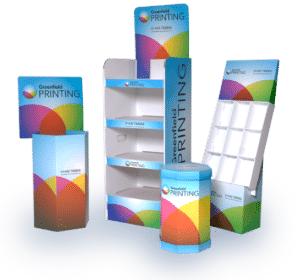Home » POP VS POS Display: What’s the Difference and Which to Choose?
POP VS POS Display: What’s the Difference and Which to Choose?

Displays play a key role in marketing and selling your product in stores. With the goal of grabbing the attention of a customer, it is important to choose the right style. There are many factors to keep in mind when deciding which display is best for your business needs.
The two main types are POP and POS displays. Making the decision between both will be based on your product and your overall company goals. With a well-designed display you can showcase your products most impressive features and have a better chance of catching your customer’s attention. It is important to understand the differences between the two in order to choose the best display for your business needs.
What is a POP Display?
A POP display refers to point of purchase which is the physical location where a consumer decides they would like to buy a product. These displays need to appeal to the customer and convince them to make a purchase. It is important that POP displays are customized with eye catching designs, in order to convince the costumer to purchase the product. These displays are meant to be placed in highly trafficked areas to ensure the maximum number of views.
There are three main types of POP displays. The first being temporary which is made with corrugated material. This is the cheaper to produce compared to the longer shelf life displays. Shelf life for this is up to 6 months. Next being semi-permanent, which is made with heavy duty corrugated, metal, wood, acrylic, and glass. The shelf life for this is 6 months to a year. Lastly is permanent which is made with plastic, metal, wood, glass and other durable materials. The shelf life is up to 3 years which makes it the longest lasting POP display.
POP Display Styles:
- Floor Display: Typically located in aisles with shopping access from all sides.
- Pallet Display: Located on a pallet and can vary in three sizes (Half, Quarter, Full)
- Power Wing (Sidekick) Display: Versatile and can be placed on endcaps or the sales floor.
- Dump Bin: Placed on the sales floor and can be accessed from all sides.
- Pallet Skirt/Wrap: A corrugated covering of a stack of pallets, which is used to hold up and display products.
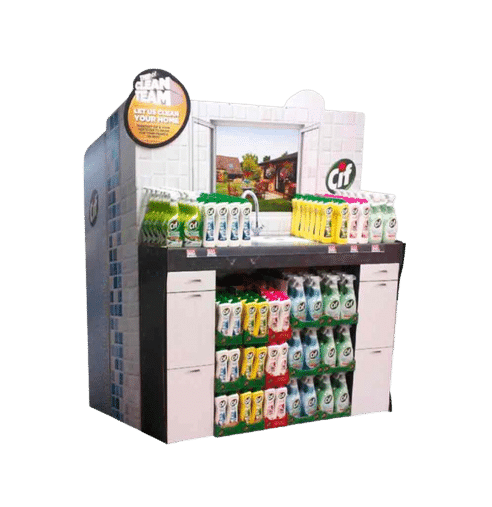
Floor

Pallet

Power Wing (Sidekick)

Dump Bin
POP Display Strengths:
- Increase brand awareness
- Showcase products and new items
- Breakaway from competition on shelf
- Placed in high traffic areas
What is a POS Display?
A POS display refers to point of sale which is the specific area where the sale takes place. These are the displays that customers interact with near the checkout or register. The purpose of these are to engage the customer in impulse purchasing. This is usually for items you didn’t plan on purchasing, but after seeing the item at check out, you impulsively chose to buy it. Since these are placed at checkouts, it’s almost a guarantee that customers will see your product.
Although these displays are small, it is still important to have an eye catching design in order to draw in the customer. Since these displays are smaller, they are best for small items and those that are individually packaged. Common examples of these are; drinks, candy, gum, and other small items located at the register.
POS Display Styles:
- PDQ Trays: Designed to fit in small places and maximize the use of retail place.
- Counter Top: Displays that are usually on a counter and designed to hold small products and fit them in compact areas with limited space.
- Power Wing (Sidekick) Display: Versatile and can be placed on endcaps or the sales floor.
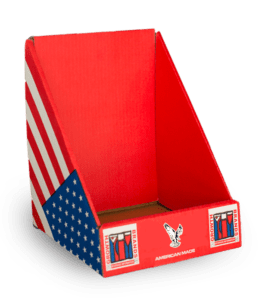
PDQ Tray
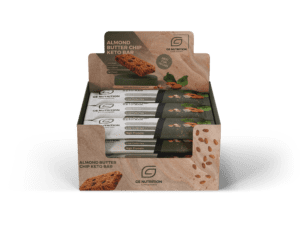
Counter Top Display
POS Display Strengths:
- At checkout, all customers will see
- Targets impulsive buyers
- Usually smaller and cheaper products
- Showcase products and new items
When to Choose a POP or POS Display:
Point of Purchase
- More costly
- Bigger displays
- More products
- Versatility and mobility to place display throughout the store
- Variety of display options and best for design
Point of Sale
- Less costly
- Smaller/individually packaged products
- Less variety of products
- Placed at check out
- Targets impulse purchases
Summary: Choosing the Right Display
Displays are a great way to stand out among your competitors. These two displays although similar, give two different approaches when it comes to showcasing your product. Choosing the right display for your business needs is important. They can come in many sizes, shapes, and designs with the common purpose of promoting and displaying your products. You must take many factors into consideration when making that decision.
If you need help deciding which display would be best for your business needs, then contact Brown Packaging today so one of our packaging specialists can assist you.
During the holiday season, packaging does more than protect—it directly influences how recipients perceive the gift inside. For e-commerce buyers, the right packaging design can
Holiday e-commerce packaging carries two expectations: delivering a memorable unboxing experience and meeting sustainability standards. Shoppers want festive branding, but they also expect recyclability and
Holiday e-commerce volumes can overwhelm manual packing operations. Automation offers a scalable way to meet peak demand while maintaining accuracy, speed, and consistency. For packaging
Point-of-purchase (POP) displays do more than attract shoppers—they must also survive the complexities of modern supply chains. From manufacturing and warehousing to transportation and in-store
Holiday returns cost retailers billions each year, with packaging failures being a major driver. Damaged goods, oversized boxes, and poor protection lead to dissatisfied customers
Unboxing has become a core part of the e-commerce experience, especially during the holidays. Seasonal packaging creates anticipation, reinforces branding, and turns customer deliveries into
Home » POP VS POS Display: What’s the Difference and Which to Choose?

When it comes to retail marketing, Point of Purchase (POP) displays are essential for capturing customer attention and promoting your products effectively. The size and

When planning a Point of Purchase (POP) display, the first and arguably most critical step is to clearly define your objectives. Setting specific, actionable goals
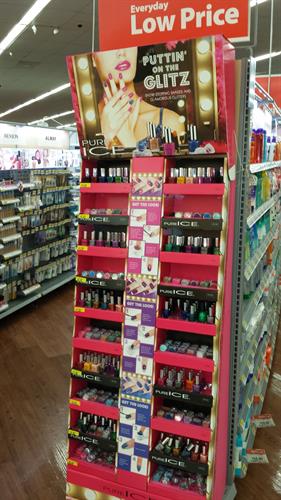
Creating an effective Point of Purchase (POP) display can be a game changer for any retail business, influencing buying decisions and enhancing product visibility. For


